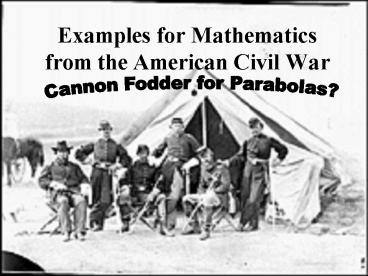Examples for Mathematics from the American Civil War - PowerPoint PPT Presentation
1 / 13
Title:
Examples for Mathematics from the American Civil War
Description:
The Golden Gate Bridge in San Francisco, California was completed on May 27, 1937. ... Golden Gate Bridge, http://www.goldengate.org ... – PowerPoint PPT presentation
Number of Views:85
Avg rating:3.0/5.0
Title: Examples for Mathematics from the American Civil War
1
Examples for Mathematics from the American Civil
War
Cannon Fodder for Parabolas?
2
Algebra 2
Introduction to Parabolas and Quadratic
Equations
3
The American Civil War, 1861-65, was one of the
most tumultuous periods in American history. The
North fought against the South, brother fought
against brother, son fought against father.
America was truly, in the words of Abraham
Lincoln, a house divided against itself.
Prior to the Civil War, military tactics had not
changed much since the Revolutionary War. Yes,
artillery had improved, but the tactics had
lagged behind. The smooth-bore flintlock had
only a range of 30-100 yards, was inaccurate,
took too much time to load. Hence the bayonet on
the end of the flintlock enabled many armies to
assault its enemies head-on.
With the advent of the Minié ball for the muzzle
loader, bayonet frontal assaults ended. The
Minié ball allowed for faster reloading and had a
range of 100-500 years.
4
Cannons and their improved performance also
aided armies chances of winning.
5
A fired cannon ball or a Minié ball follows a
path known as a parabola.
The graph of a polynomial of degree 2 is called a
parabola, and it has a particular shape.
Some parabolas have a high arching shape, like
that of the Saint Louis Arch or a launched
rocket. Some parabolas have a flatter arching
shape, like that of a baseball pitchers fastball
or a rifle bullet.
6
Think of a water fountain. You are standing at
the water fountain waiting to get a drink. When
you turn the knob, the water comes out of the
spout. It shoots up, curving, and then falls.
The shape the water creates as it comes out of
the spout is a parabola.
Think of a baseball game. When the batter hits a
fly ball, the path the ball creates when it
leaves the bat is a parabola.
7
The general equation for a parabola is
also known as a quadratic equation. But when we
think of arching water or baseballs in flight,
the formula we use is
where g is the force of gravity, v0 is the
projectiles initial velocity, and h is the
initial height.
8
Lets look at some examples.
If a tennis ball is hit upward with an initial
velocity of 48 feet per second, then the equation
to model the height of the ball is
9
In 1940, Emanual Zacchini of Italy was fired from
a cannon and traveled a distance of 175 feet.
Suppose his initial velocity was 80 feet per
second. Then the equation to model The Amazing
Zacchinis height after being shot out of the
cannon is
10
With this equation we can determine how long
Zacchini was in the air as well as finding his
maximum height. We can do the same with the
tennis ball we can find its maximum height, how
long it was in the air, and how far from the
hitter the it landed.
Parabolas are useful in engineering also. The
Golden Gate Bridge in San Francisco, California
was completed on May 27, 1937. It took 4 years
to build and cost 27 million. Its towers rise
746 feet above the water, and the floor of the
bridge is 200 feet above the water.
The two supporting cables that pass over the tops
of the towers are each 7650 feet long and 36.5
inches in diameter. These supporting cables
approximate the shape of a parabola with the
lowest point about 6 feet above the floor of the
bridge.
11
This parabola can be modeled with the equation
where f(x) is the height of the cables.
12
Lets look now at parabolas and their properties.
13
Bibliography
Robert Leckie, The Wars of America (New York
harper Row, Publishers, 1968). Algebra 2
Integrations, Applications, Connections (New
York Glencoe, McGraw-Hill, 1998). Web
Sites Golden Gate Bridge, http//www.goldengate.
org (St. Louis) Arch History and Architecture,
http//www.nps.gov/htdocs4/jeff/arch-ov.htmTo
p Civil War Artillery Page, http//www.cwa
rtillery.org/cwartiller.html Abraham
Lincoln, http//www.ipl.org/ref/POTUS/alinco
ln.html The American Civil War Homepage,
http//sunsite.utk.edu/civil-war/warweb.html































